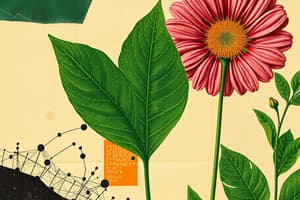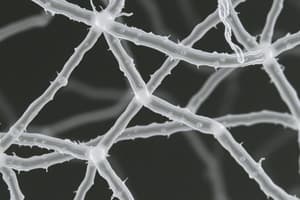Podcast
Questions and Answers
Which of the following statements correctly differentiates between Eukaryotic and Prokaryotic cells?
Which of the following statements correctly differentiates between Eukaryotic and Prokaryotic cells?
- Prokaryotic cells are always larger than Eukaryotic cells.
- Eukaryotic cells are unicellular; Prokaryotic cells are multicellular.
- Eukaryotic cells have a nucleus; Prokaryotic cells do not. (correct)
- Both Eukaryotic and Prokaryotic cells have a nucleus.
Unicellular organisms perform all life activities using multiple cells.
Unicellular organisms perform all life activities using multiple cells.
False (B)
What is the branch of biology that deals with the form and structure of living organisms?
What is the branch of biology that deals with the form and structure of living organisms?
Morphology
Eukaryotic cells are typically larger than _____ cells.
Eukaryotic cells are typically larger than _____ cells.
Match the following cell characteristics with their corresponding cell type:
Match the following cell characteristics with their corresponding cell type:
What is the primary function of mitochondria in a plant cell?
What is the primary function of mitochondria in a plant cell?
Chloroplasts are responsible for cell division in plant cells.
Chloroplasts are responsible for cell division in plant cells.
What role does the nucleolus play in the cell?
What role does the nucleolus play in the cell?
The organelle responsible for controlling all activities of the cell is the ______.
The organelle responsible for controlling all activities of the cell is the ______.
Match each organelle with its main function:
Match each organelle with its main function:
Flashcards are hidden until you start studying
Study Notes
Morphology of Plants
- Morphology is a branch of biology studying the form and structure of organisms, including plants.
- The cell theory states that plants and animals are made up of microscopic cells.
- Organisms can be unicellular, consisting of a single cell, or multicellular, with many cells working together.
- Multicellular organisms have organs, tissues, and cells that work together to carry out life functions.
- Unicellular organisms perform all life activities within a single cell.
Plant Cell Types
- Prokaryotic cells lack a nucleus and membrane-bound organelles.
- Eukaryotic cells have a nucleus and membrane-bound organelles.
Plant Cell Organelles
- Mitochondria transform chemical energy into biological energy in the form of ATP.
- Mitochondria contain all enzymes involved in the Krebs cycle.
- Plastids play a vital role in plant metabolism, with chloroplasts capturing solar energy for photosynthesis.
- The nucleus controls all cell activities and is involved in cell division.
- The nucleolus is responsible for the secretion of ribosomal subunits.
- Collenchyma is a supporting tissue similar to parenchyma, but with thickened primary cell walls for mechanical strength.
- Collenchyma may or may not have intercellular spaces and may contain chloroplasts.
Plant Tissues
- Permanent tissues are fully differentiated and mature, unable to divide further.
- Simple permanent tissues consist of one type of cell, while complex tissues have multiple cell types working together.
Simple Permanent Tissues
- Parenchyma are thin-walled cells with large vacuoles that store food, water, and waste.
- Collenchyma provide support and flexibility, especially in young stems and leaves.
- Sclerenchyma are thick-walled cells that provide structural support and strength to mature parts of the plant.
- Cork is a protective tissue with densely packed, dead cells forming the bark of stems and roots.
Complex Permanent Tissues
- Xylem is the main water-conducting tissue associated with the phloem in vascular tissues.
- Xylem components include parenchyma, fibres, and tracheary elements (tracheids and vessel members).
- Tracheary elements are elongated, non-living cells with thickened cell walls.
- Xylem vessels are open tubes formed by joining vessel members, while tracheids are closed.
- Phloem is the main food-conducting tissue in plants.
- Phloem components include sieve tubes, companion cells, parenchyma, and fibers.
- Sieve tubes are long, cylindrical cells connected by sieve plates.
- Companion cells are associated with sieve tubes and help in the loading and unloading of sugars.
Secretory Structures
- Secretory structures produce and secrete various substances like resins, gums, oils, and tannins.
- Lateciferous tissues are cells or vessels containing latex, a milky or colored liquid.
- Latex is a complex mixture of chemicals including alkaloids, enzymes, and proteins.
- Latex function is still not fully understood, but it is believed to play a role in defense against herbivores.
Conducting Tissues - Vascular Bundles
- Vascular bundles are groups of xylem and phloem that transport fluids throughout the plant.
- Radial bundles are found in roots, with xylem arranged in the center and phloem alternating with it.
- Collateral bundles are found in stems, with xylem in the center and phloem outside of it.
- Open collateral bundles have cambium present between xylem and phloem (dicotyledonous plants).
- Closed collateral bundles lack cambium (monocotyledonous plants).
- Bi-collateral bundles have xylem in the center, with cambium and phloem on both sides
- Concentric bundles either have xylem in the center surrounded by phloem (centroxylic) or phloem in the center surrounded by xylem (centrophilic).
Tissue Systems
-
The epidermal tissue system forms the outermost layer of the plant and its covering cuticle.
-
The epidermal tissue system consists of epidermis, trichomes, and openings (stomata and water pores).
-
The epidermal tissue system functions in protection, aeration, control of water loss, and absorption of nutrients from the soil.
-
The ground tissue system forms the bulk of the plant and includes parenchyma, collenchyma, and sclerenchyma.
-
The ground tissue system functions in food formation, food storage, aeration, and mechanical strength.
-
The vascular tissue system is composed of xylem and phloem, responsible for long-distance transport of water and nutrients throughout the plant.
-
The vascular tissue system may or may not contain cambium, a meristematic tissue that produces new xylem and phloem cells.
Studying That Suits You
Use AI to generate personalized quizzes and flashcards to suit your learning preferences.





